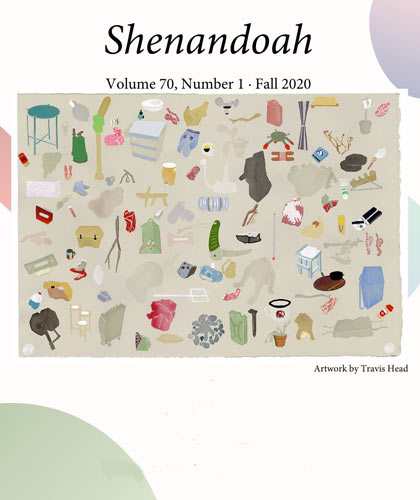Shenandoah – Fall 2009
Volume 59 Number 2
Fall 2009
Quarterly
Sally Molini
As usual there are great poems and stories in the latest issue of Shenandoah, though I must say that the two essays, Jeffrey Hammond’s engaging “My Father’s Hats, and a wrenching must-read by Shari Wagner, “Camels, Cowries & A Poem for Aisha,” about harrowing conditions in Somalia, are stand-outs. Set within the frame of a memoir, Jeffrey Hammond’s essay, “My Father’s Hats,” is an entertaining history of the hat, beginning with the snug pilos, the Greek name for a common, helmet-shaped cap made of felt. I sat at my computer as I read, Googling the names of hats as Hammond’s prose moved through the centuries.
As usual there are great poems and stories in the latest issue of Shenandoah, though I must say that the two essays, Jeffrey Hammond’s engaging “My Father’s Hats, and a wrenching must-read by Shari Wagner, “Camels, Cowries & A Poem for Aisha,” about harrowing conditions in Somalia, are stand-outs. Set within the frame of a memoir, Jeffrey Hammond’s essay, “My Father’s Hats,” is an entertaining history of the hat, beginning with the snug pilos, the Greek name for a common, helmet-shaped cap made of felt. I sat at my computer as I read, Googling the names of hats as Hammond’s prose moved through the centuries.
Shari Wagner’s essay discusses life in troubled Somalia, a country she describes as a terribly “harsh place for women – especially during their childbearing years.” Wagner’s article includes the stoning of thirteen-year-old Aisha who, after having informed the militia that she had been raped by three men, was executed for adultery. How the image of a cowrie shell fits into Wagner’s narrative is painfully apt and devastatingly poetic.
Poetry claims the largest section of this issue, with several pieces being about animals, birds, insects, hunting, and fishing. Margaret Reges’s two poems are beautiful, with long, undulating lines filled with in-the-moment detail. “Saguaro,” a piece by Pablo Peshiera, is an arresting depiction of Cabeza de Vaca, Spanish explorer of the New World, its piercing lines spoken by a native voice. Wendell Hawken’s “Elegaic” and “A View” are deftly rendered poems on two different kinds of hunting; and Katy Didden’s “Mind’s-Eyed Island,” about Surtsey, Earth’s newest island, is set in triplets and reminds the reader where “earth’s beginning gets re-set” and that it is “so hard to leave be what the law ropes off.”
The six stories that appear in this issue share various threads of sex and precarious situations in which the characters often feel cornered. Holly Goddard Jones’ story, “Allegory of a Cave,” is a rather reluctant coming-of-age tale about Ben, a ten-year-old whose eyesight is deteriorating; his other cross to bear is his can’t-be-intermittent-enough relationship with his father. Jones’ tale reminds this reader of how children are constantly at the mercy of a parent’s state of mind. Sheba Karim’s fiction piece, “Telescope,” offers a meaningful glimpse into the life of a Pakistani couple, Firoze and Fariha, living in a suburban neighborhood, the title suggesting that objects observed from a distance may be colored with the viewer’s own projections.
An interview with fiction writer Robert Olmstead closes the issue. Responding to interviewer Bruce Bays’s question on the habits of a writer, Olmstead answers, “Your ear becomes a sort of pickup, a mike for all kinds of ambient conversations, ambient sound, the turns of phrase.” Shenandoah’s does indeed reflect current ambient conversations: always with us are creatures of nature; acts of violence of one kind or another; the birth of something new, even land; abuse; prejudice – all reflect human states of consciousness, ransacking, empathetic, harsh, generous, etc. Whether poem, essay or story, all the pieces here stand as witness to the wide, raging vicissitudes of human perception, which are, as always, both real and imagined.
[www.wlu.edu/x31904.xml]


